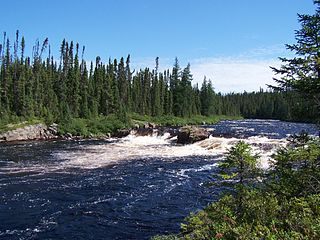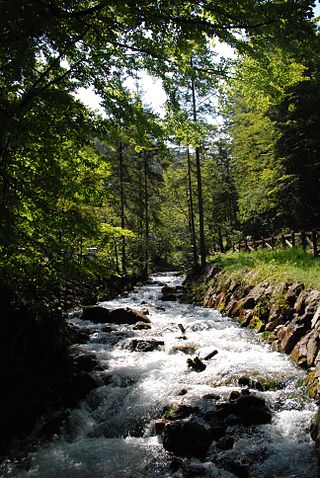
Brights Grove is a neighbourhood of Sarnia, Lambton County, Ontario, Canada. Brights Grove is located on the shore of Lake Huron.

The Huron River is a 130-mile-long (210 km) river in southeastern Michigan, rising out of the Huron Swamp in Springfield Township in northern Oakland County and flowing into Lake Erie, as it forms the boundary between present-day Wayne and Monroe counties. Thirteen parks, game areas, and recreation areas are associated with the river, which passes through the cities of Dexter, Ann Arbor, Ypsilanti, Belleville, Flat Rock and Rockwood that were developed along its banks.

The Ausable River is a river in southwestern Ontario Canada which empties into Lake Huron at Port Franks, Ontario. The Ausable's initial source is in a moraine near the community of Staffa, Ontario located in the municipality of West Perth, Ontario at a point 334 metres (1,096 ft) above sea level. Although the river has a total measured length of over 240 kilometres (150 mi), because of its meandering course, the mouth in actuality is only 64 kilometres (40 mi) from its source near Staffa. The Ausable drains 1,142 square kilometers (441 sq mi) of land, and falls 158 metres (518 ft) in elevation from source to outlet.

The Slave River is a Canadian river that flows from the confluence of the Rivière des Rochers and Peace River in northeastern Alberta and empties into Great Slave Lake in the Northwest Territories. The river's name is thought to derive from the name for the Slavey group of the Dene First Nations, Deh Gah Got'ine, in the Athabaskan language. The Chipewyan had displaced other native people from this region.

New Hope Creek is a watercourse that rises in rural Orange County, North Carolina, in the United States. It drains the western portion of Orange County and the southern half of Durham County and flows into the northern end of Jordan Lake reservoir. The drainage area encompasses urban, suburban and rural lands. Formerly the New Hope River, it was a tributary of the Cape Fear River until it was dammed to create Jordan Lake. Construction of the lake began in 1973, after a comprehensive study of regional water management by the U.S. Army Corps of Engineers, motivated by major flooding in a 1945 hurricane. Several communities draw drinking water from Jordan Lake, increasing interest in protection of the New Hope Creek watershed.

Daylighting can be defined as "opening up buried watercourses and restoring them to more natural conditions". An alternative definition refers to "the practice of removing streams from buried conditions and exposing them to the Earth's surface in order to directly or indirectly enhance the ecological, economic and/or socio-cultural well-being of a region and its inhabitants". The term is used to refer to the restoration of an originally open-air watercourse, which had at some point been diverted below ground, back into an above-ground channel. Typically, the rationale behind returning the riparian environment of a stream, wash, or river to a more natural state is to reduce runoff, create habitat for species in need of it, or improve an area's aesthetics. In the UK, the practice is also known as deculverting.

Beaver River is a large river in east-central Alberta and central Saskatchewan, Canada. It flows east through Alberta and Saskatchewan and then turns sharply north to flow into Lac Île-à-la-Crosse on the Churchill River which flows into Hudson Bay.

The Mistassini River is a river in central Quebec, Canada, draining into the north-western portion of Lac Saint-Jean. It is 298 kilometres (185 mi) long and has a watershed area of 21,900 square kilometres (8,500 sq mi). Its source is between Eau Froide and De Vau Lakes in the northernmost portion of the Rivière-Mistassini Unorganized Territory, just east of the vast Baie-James Municipality.

The Mistassibi River is a river in central Quebec, Canada. It is 298 kilometres (185 mi) long and has a drainage basin of 9,325 square kilometres (3,600 sq mi). Its source is an area with unnamed lakes about 50 kilometres (31 mi) east of Canso Bay of Lake Albanel, eastern neighbor of Lake Mistassini.

Santry River is a fairly small river on the north side of Dublin city, one of the forty or so watercourses monitored by Dublin City Council.
An ordinary watercourse is one of the two types of watercourse in statutory language in England and Wales.

A stream is a continuous body of surface water flowing within the bed and banks of a channel. Depending on its location or certain characteristics, a stream may be referred to by a variety of local or regional names. Long, large streams are usually called rivers, while smaller, less voluminous and more intermittent streams are known as streamlets, brooks or creeks.
The ZEC Forestville is a "zone d'exploitation contrôlée" (ZEC) in the unorganized territory of the Lac-au-Brochet, in La Haute-Côte-Nord Regional County Municipality, in Quebec, in Canada. The area was designated a zone d'exploitation contrôlée in 1978.
The Chigoubiche River is a tributary of the Ashuapmushuan River, flowing into the unorganized territory of Lac-Ashuapmushuan, Quebec and then into the Regional County Municipality (RCM) of Le Domaine-du-Roy, in the administrative region of Saguenay-Lac-Saint-Jean, in the province of Quebec, in Canada.
Chief Joshua Wawanosh was a First Nations leader of Ojibwe descent, who lived near the southern shore of Lake Huron. He was born near Lake Superior. One source says he had to leave the Lake Superior area after he killed someone.

Cold Creek is a river of Mendocino County, California, a tributary of East Fork Russian River. In the past it may have connected Clear Lake to the Russian River before this route was blocked by a large landslide and Clear Lake began to drain into the Sacramento River watershed.

The Blue Lakes are a string of two or three lakes in Lake County, California, set in a deep canyon. At one time they seem to have been in the Russian River watershed, but a recent geological upheaval cut them off from that basin and they now drain via Scotts Creek into Clear Lake in the Sacramento River basin. In the 19th and early 20th centuries there were several resorts around the lakes. Their waters have been highly altered by human activity and most of their native fish are lost, but they have a healthy population of largemouth bass.













